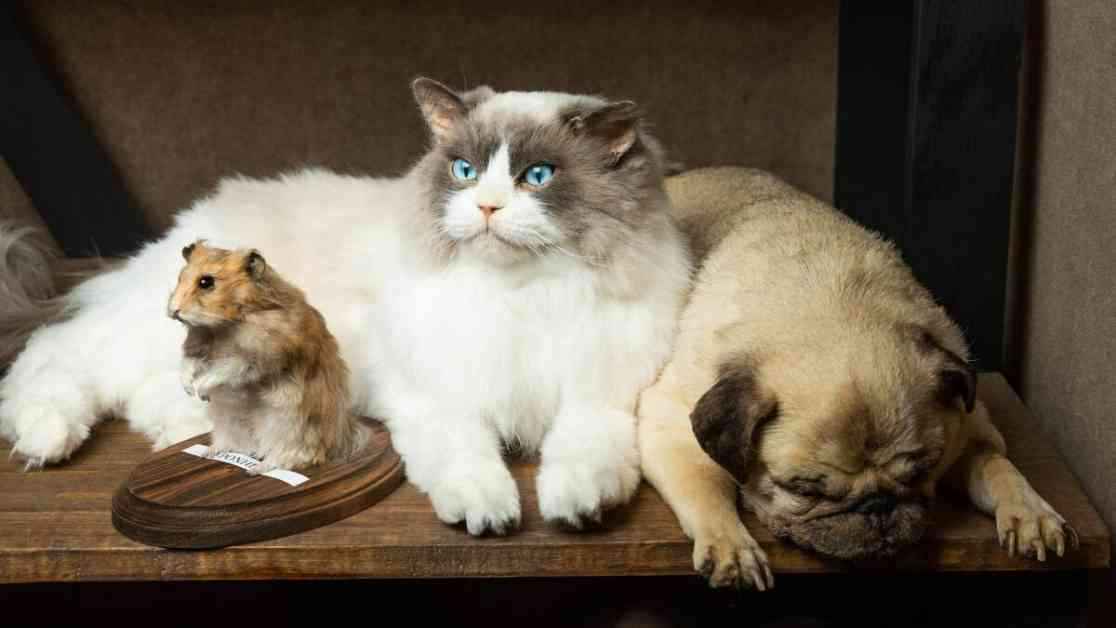In a room inside a North Hollywood warehouse, dozens of pets are ready for their owners to take them home. Boots, a young black-and-white domestic shorthair cat, lies on his back, pawing playfully at the air. A trio of red, yellow, and green parrots and cockatiels sit on wooden perches, oblivious to the piercing stare of a blue-eyed feline a few feet away. Princess, a senior Chihuahua, rests with her eyes closed and body curled into a tight cocoon, as a frenetic hamster named Ponby stands upright, his eyes bulging. There’s a naked guinea pig, a giant red macaw, and an adorably chunky pit bull named Messy.
All of these animals are loose, liberated from the confines of cages and leashes, and yet no havoc has ensued. These animals are also all dead. It’s an everyday scene at Bischoff’s the Animal Kingdom, a Los Angeles taxidermy business that has been preserving animals for 103 years. The business is multifold — Bischoff’s creates and rents out prop animals to film studios, museums, and nature centers. Posters on the lobby walls boast the company’s work on shows like “American Horror Story” and “Westworld.” But in recent years, a bulk of its taxidermy requests now come from bereaved pet owners, those willing to shell out thousands of dollars for a tangible commemoration of their late “fur babies.”
Birds are commonly preserved at Bischoff’s, but the business has made mementos of more obscure pets, including chameleons, roosters, and hairless guinea pigs. From full-body taxidermy to partial mementos — skulls, bronzed hearts, or freeze-dried paws, for example — such services provide closure in ways that, clients say, traditional burials or urns cannot. “It was honestly really comforting to have her back, and just be able to touch her and, in a sense, talk to her too,” said Bischoff’s customer Zoe Hays of the preservation of her Chihuahua-Yorkie mix Pixie. “She was a great little dog — also a menace to society, for sure — but she’s still with me, and she always will be.”
### Blending Artistic Skill with Scientific Knowledge
Ace Alexander, 40, and Rey Macias, 55, the fourth owners in Bischoff’s long history, have steered the company to meet the new demand. Describing each other as “good friends,” the two men dress similarly in unofficial uniforms of black T-shirts and black pants, and they’re so in sync they sometimes finish each other’s thoughts. Since taking over the business, both have transitioned to primarily vegan diets. “Bischoff’s used to be taxidermists to the stars in the trophy era, but now we’re taxidermists in the pet preservation era,” Alexander said. “People no longer hunt. Now they just love their pets.”
Over the decades, Bischoff’s has preserved hundreds of animals. The Sumatran tiger has made many appearances in films and TV shows, including “Snowfall,” “Palm Royale,” and “Welcome to Chippendales.” In 1922, when Al Bischoff first opened the business on Sunset Boulevard in Hollywood, he’d stuff and plaster any animal brought to him. Most of the time, that meant trophies from hunting and safari trips, but it also included beloved pets owned by Hollywood elite. Roy Rogers used Bischoff’s to preserve his co-stars Trigger the horse and Bullet the dog. Buck — the dog from “Married with Children” — also got the Bischoff’s treatment.
### Bischoff’s Key Component? Compassion
In the back of Bischoff’s warehouse is where the equipment resides and the smells of the oils running the machines permeate the space. The company has one aquamation machine that uses alkali solution, heat, and pressure to break down the organic material into ashes. With interior chambers lined with perforated metal walls, the contraption somewhat resembles a fast-food restaurant’s deep fryer. Except, one taxidermist notes, when the process is done, instead of having golden fried potato strips in each basket, all that is left are bones. Oftentimes at the ends of these processes, Bischoff’s workers will find inorganic remnants from the pets, such as microchips, metal plates, or orthopedic screws. They give them to their owners as keepsakes.


